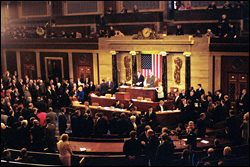Voter News Service
What the
viewer sees on election night, and in the newspaper
the next morning, is the culmination of months of
preparation and planning. A key entity in bringing the
results to the nation is Voter News Service, a
cooperative formed by ABC News, the Associated Press,
CBS News, Cable News Network, Fox News and NBC News.
VNS performs two distinct functions. First, it does
Election Day exit polling, surveying voters in
randomly selected precincts as they leave polling
places. On November 5, 1996 VNS's national exit poll
surveyed 14,651 voters in 300 randomly selected
precincts. VNS also does individual state exit polls.
Exit polls provide a window on the concerns of voters
and useful information on variations in voting
behavior by gender, race, age, education, income and
other factors. VNS's second function is to collect,
tabulate and distribute unofficial election night
vote results for presidential, Senate, House and
gubernatorial races. VNS works with election officials
in every county in the country to gather these
results. On election night, stringers and reporters in
tens of thousands of precincts around the country call
in reports to VNS, which then processes and transmits
the information.
Showtime
For news
organizations, election night is as good as it gets, a
chance to show what they can do. Anchors man
elaborate sets, correspondents around the country file
reports, and, as the evening progresses, states are
called one way or another and the map begins to fill
in with red and blue. The Long Night
Defeat...And
Victory Gore Election
Night
At some point
in the evening, the outcome has become apparent to
all, not just those with access to the exit
polls. The defeated candidate calls the victor
to concede and then delivers his or her concession
speech. The president-elect delivers his or her
victory speech to jubilant supporters.
The Morning After...What
Does It Mean?
The days
after the election are peak season for pundits as they
assess, analyze, discuss and debate the meaning of the
results. Various interest groups offer their own
post-election assessments, often using the opportunity
to point to the impact their constituency had on the
outcome or to launch some barbs at their opponents.
Election Day: Take 2...The
Electoral
College
Photos
As you will
recall from high school, the president is not selected
by direct popular vote, but by intermediaries known as
electors. The electoral system is outlined in the
Twelfth Amendment to the Constitution, adopted in 1804
(this significantly modified the original provisions
contained in Article II). Each state has a number of
electors equal to its number of congressmen and
Senators. The District of Columbia has three electors,
bringing the total to 538. Most states use a
winner-take-all rule; all the state's electors go to
the winner of the popular vote in the state.
Electors are generally party activists. Some months before the election each party puts together a slate of electors, chosen by congressional district with the exception of the two at-large Senate slots. If the party's presidential candidate wins the popular vote in the state on Election Day, its electors meet in the state capitol on the first Monday after the second Wednesday in December 2000. If not they stay home.
Gathering for the mid-December ceremony at the state capitol, electors sign the certificate of vote--actually they sign several copies of the document so there are back-ups. There are separate votes for president and for vice president. Each state sends one copy of the certificate of vote to the Office of the President of the United States Senate. Finally, on January 6th, in a special joint session of Congress these envelopes are opened and tallied and the outcome of the election is officially certified.
 |
Normally this is a routine affair. Because of the Florida controversy, some Democrats [Democrats.com] still had not given up on January 6, 2001 even though Vice President Gore had conceded. Members of the Congressional Black Caucus tried to get Congress to reject Florida's electors, but they could not find a Senator to support their effort [as required by 3 U.S.C. Sect. 15]. |
| Jan. 6, 2001--Vice President Al Gore presided over the joint session of Congress that certified George W. Bush as the winner of the 2000 election. |
Voter Turnout in Recent Years1
| Year | Voting Age Population (VAP) | Total Vote | % VAP Voted |
| 2000 | 205,814,000 | 105,396,475 | 51.2 |
| 1996 | 196,507,000 | 96,277,634 | 49.8 |
| 1992 | 182,628,000 | 104,428,377 | 55.2 |
| 1988 | 182,628,000 | 91,594,805 | 50.1 |
| 1984 | 164,595,000 | 92,653,000 | 53.1 |
| 1980 | 164,595,000 | 86,497,000 | 52.6 |
| 1976 | 152,308,000 | 81,603,000 | 53.5 |
| 1972 | 140,777,000 | 77,625,000 | 55.2 |
1. For the five presidential elections from 1952-1968, turnout hovered around 60%.
Election Night Coverage:
What Went Wrong
The House
Subcommittee on Telecommunications, Trade & Consumer
Protection (Commerce), chaired by Rep. Billy Tauzin
(R-LA), held hearings on the effects of the networks'
election night projections on Feb. 14, 2001.
CNN commissioned an independent review panel which
produced a report [Joan
Konner,
James Risser, and Ben Wattenberg. "Television's
Performance on Election Night 2000: A Report for CNN,"
Jan. 29, 2001] (PDF format), and it is instituting new
policies for election night coverage.
American
Antitrust
Institute Calls for Break Up of VNS (11/27/00)
More Useful Links
National Election
Studies NES
"Guide
to Public Opinion and Electoral Behavior"
Electoral
College
(National
Archives site)
Resolution
Proposing
That the Electoral College Be Abolished
Citizens
for True Democracy (seeks abolition of Electoral
College)
1992 and 1996 Maps and Results
Copyright 1998, 1999, 2000, 2001 Eric M. Appleman/Democracy in Action.
